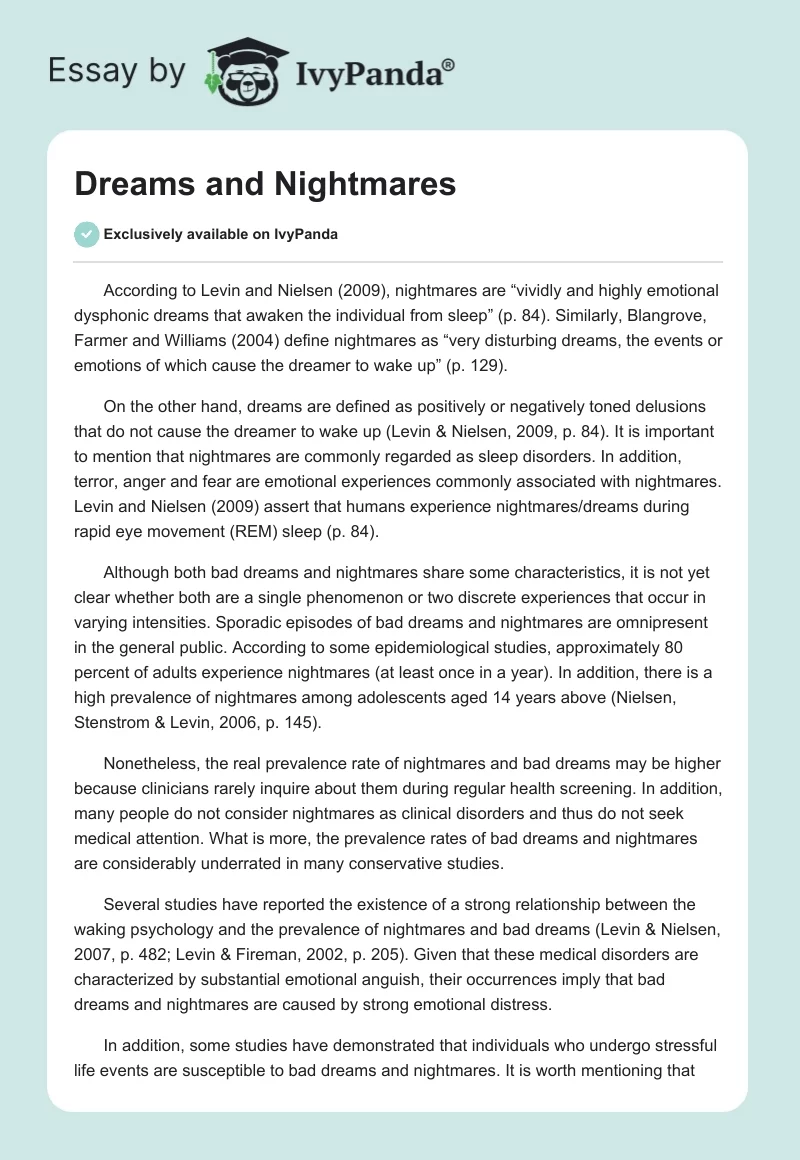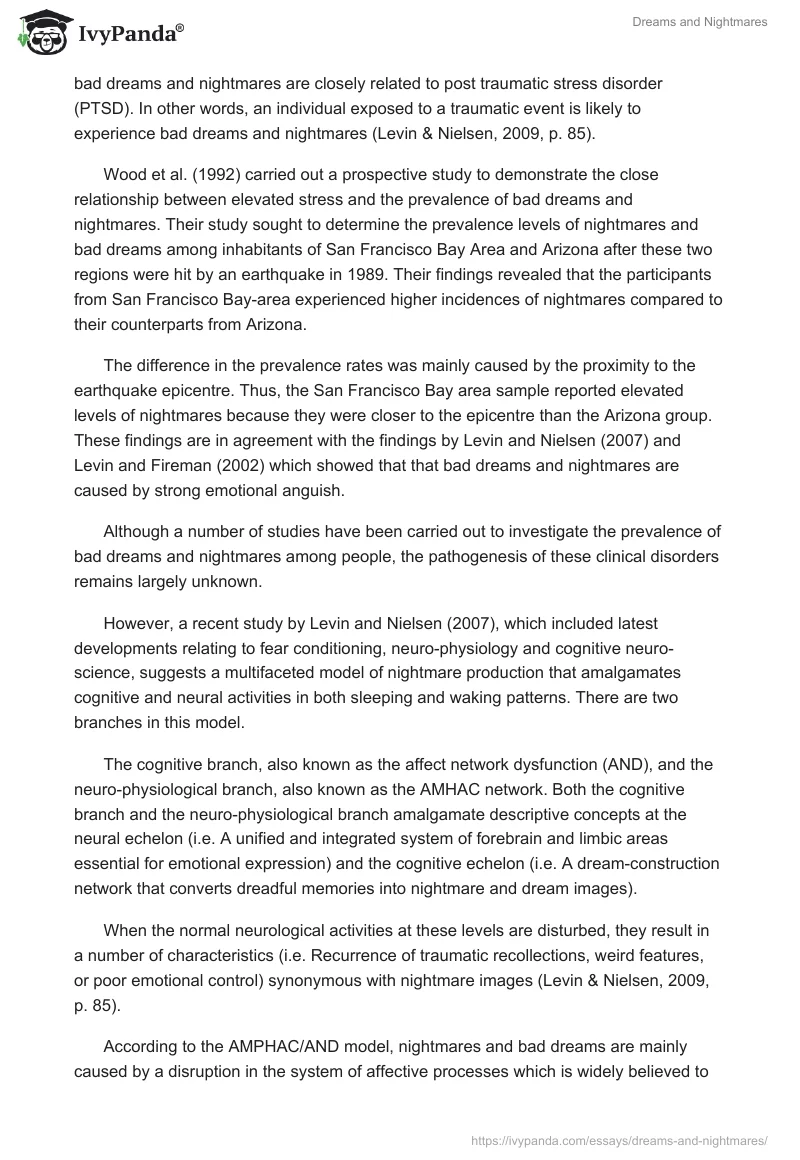According to Levin and Nielsen (2009), nightmares are “vividly and highly emotional dysphonic dreams that awaken the individual from sleep” (p. 84). Similarly, Blangrove, Farmer and Williams (2004) define nightmares as “very disturbing dreams, the events or emotions of which cause the dreamer to wake up” (p. 129).
On the other hand, dreams are defined as positively or negatively toned delusions that do not cause the dreamer to wake up (Levin & Nielsen, 2009, p. 84). It is important to mention that nightmares are commonly regarded as sleep disorders. In addition, terror, anger and fear are emotional experiences commonly associated with nightmares. Levin and Nielsen (2009) assert that humans experience nightmares/dreams during rapid eye movement (REM) sleep (p. 84).
Although both bad dreams and nightmares share some characteristics, it is not yet clear whether both are a single phenomenon or two discrete experiences that occur in varying intensities. Sporadic episodes of bad dreams and nightmares are omnipresent in the general public. According to some epidemiological studies, approximately 80 percent of adults experience nightmares (at least once in a year). In addition, there is a high prevalence of nightmares among adolescents aged 14 years above (Nielsen, Stenstrom & Levin, 2006, p. 145).
Nonetheless, the real prevalence rate of nightmares and bad dreams may be higher because clinicians rarely inquire about them during regular health screening. In addition, many people do not consider nightmares as clinical disorders and thus do not seek medical attention. What is more, the prevalence rates of bad dreams and nightmares are considerably underrated in many conservative studies.
Several studies have reported the existence of a strong relationship between the waking psychology and the prevalence of nightmares and bad dreams (Levin & Nielsen, 2007, p. 482; Levin & Fireman, 2002, p. 205). Given that these medical disorders are characterized by substantial emotional anguish, their occurrences imply that bad dreams and nightmares are caused by strong emotional distress.
In addition, some studies have demonstrated that individuals who undergo stressful life events are susceptible to bad dreams and nightmares. It is worth mentioning that bad dreams and nightmares are closely related to post traumatic stress disorder (PTSD). In other words, an individual exposed to a traumatic event is likely to experience bad dreams and nightmares (Levin & Nielsen, 2009, p. 85).
Wood et al. (1992) carried out a prospective study to demonstrate the close relationship between elevated stress and the prevalence of bad dreams and nightmares. Their study sought to determine the prevalence levels of nightmares and bad dreams among inhabitants of San Francisco Bay Area and Arizona after these two regions were hit by an earthquake in 1989. Their findings revealed that the participants from San Francisco Bay-area experienced higher incidences of nightmares compared to their counterparts from Arizona.
The difference in the prevalence rates was mainly caused by the proximity to the earthquake epicentre. Thus, the San Francisco Bay area sample reported elevated levels of nightmares because they were closer to the epicentre than the Arizona group. These findings are in agreement with the findings by Levin and Nielsen (2007) and Levin and Fireman (2002) which showed that that bad dreams and nightmares are caused by strong emotional anguish.
Although a number of studies have been carried out to investigate the prevalence of bad dreams and nightmares among people, the pathogenesis of these clinical disorders remains largely unknown.
However, a recent study by Levin and Nielsen (2007), which included latest developments relating to fear conditioning, neuro-physiology and cognitive neuro-science, suggests a multifaceted model of nightmare production that amalgamates cognitive and neural activities in both sleeping and waking patterns. There are two branches in this model.
The cognitive branch, also known as the affect network dysfunction (AND), and the neuro-physiological branch, also known as the AMHAC network. Both the cognitive branch and the neuro-physiological branch amalgamate descriptive concepts at the neural echelon (i.e. A unified and integrated system of forebrain and limbic areas essential for emotional expression) and the cognitive echelon (i.e. A dream-construction network that converts dreadful memories into nightmare and dream images).
When the normal neurological activities at these levels are disturbed, they result in a number of characteristics (i.e. Recurrence of traumatic recollections, weird features, or poor emotional control) synonymous with nightmare images (Levin & Nielsen, 2009, p. 85).
According to the AMPHAC/AND model, nightmares and bad dreams are mainly caused by a disruption in the system of affective processes which is widely believed to eradicate frightful memories. As a matter of fact, the fundamental bio-chemistry and neuro-physiology of rapid eye movement sleep seems to be in a position to turn on these networks.
The model suggests that dreaming (i.e. At the cognitive echelon) aid in the eradication of frightful memories via emotional expression, memory-factor recombination, and memory-factor activation (Levin & Nielsen, 2009, p. 85).
The memory-aspect activation demotes the amplified existence of different memory constituents during dreaming. For instance, some dream scholars assert that dreams do not necessarily reflect logical episodic recollections. On the contrary, sleep and dream scholars believe that the disintegration of memories into fundamental elements or distinct units is an exceptional characteristic of dreaming. The memory-factor recombination process merges distinct elements of a memory into a stable and logical pattern of dream images.
According to Levin and Nielsen (2009), this process takes place during dreaming whereby the frameworks of new images are generated for extreme emotional and stimulating memorial ingredients (p. 85). They state further that the new memorial images are converted into virtual imitations that have dramatic influence on limbic structures in a similar fashion to that which takes place when a person wakes up (Levin & Nielsen, 2009, p. 85).
The emotional expression process is considered an important phase in alleviating frightful dreams since it optimizes the participation of neural structures in facilitating sufficient employment of awareness assets that control harmful emotional. It appears that the rapid eye movement sleep is mainly responsible for engaging processes of fear extinction.
What is more, the day to day activities that exert pressure on the emotional memory system affect the manner in which specific memorial elements are characterized in the dream context (Levin & Nielsen, 2009, p. 85).
As demonstrated above, bad dreams and nightmares are closely associated with stressful life events. What is more, several studies have reported higher prevalence rates of these clinical disorders among young adults and women than grown-up adults. As noted earlier, the prevalence of nightmares and bad dreams is not well documented because clinicians rarely inquire about them in regular health screening. Thus, efforts must be made to inform the public that nightmares are clinical conditions that required medical attention.
References
Blangrove, M., Farmer, L., & Williams, E. (2004). The relationship of nightmare frequency and nightmare distress to well-being. J. Sleep. Res, 13 (2),129-136.
Levin, R., & Fireman, G. (2002). Nightmare prevalence, nightmare distress, and self reported psychological disturbance. Sleep, 25(2) 205–212.
Levin, R., & Nielsen, T. (2009). Nightmares, Bad Dreams, and Emotion Dysregulation. Cureent Direction in Psychological Science, 18 (2), 84-88.
Levin, R., & Nielsen, T. (2007). Disturbed dreaming, post traumatic stress disorder, and affect distress: A review and neurocognitive model. Psychological Bulletin, 133 (3), 482–528.
Nielsen, T., Stenstrom, P., & Levin, R. (2006). Nightmare frequency by age, gender and 9/11: Findings from an Internet questionnaire. Dreaming, 16 (3), 145–158.
Wood, J.M., Bootzin, R.R., Rosenhan, D., Nolen-Hoeksema, S., & Jourden, F. (1992). Effects of the 1989 San Francisco earthquake on frequency and content of nightmares. Journal of Abnormal Psychology, 101(2), 219–224.


